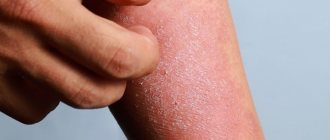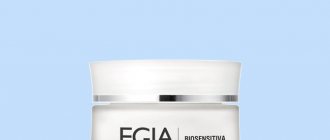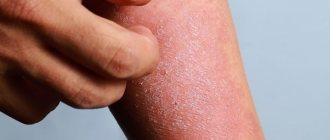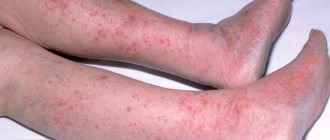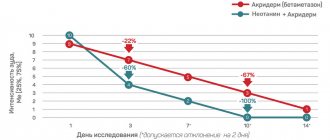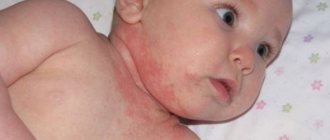The human skin performs an important function - it protects the body from the adverse effects of the environment. This explains why there are so many skin diseases. Atopic dermatitis is considered one of the most severe and complex. This is an inflammation of the skin that is allergic in nature. Treatment of atopic dermatitis takes a long time because it is a chronic disease. It occurs in waves, with periods of exacerbation and remission.
What it is?
Atopic dermatitis (AD) is an allergic skin disease that usually occurs in early childhood in people with a hereditary predisposition to atopic diseases, has a chronic relapsing course, age-related features of the localization and morphology of inflammation, characterized by skin itching and caused by hypersensitivity to both allergens and non-specific irritants.
The problem of AD is becoming increasingly important in modern medicine. The increase in incidence in the last 10 years, the chronic course of the disease with frequent relapses, and the insufficient effectiveness of existing methods of treatment and prevention make this disease one of the most pressing medical problems.
Atopic dermatitis is largely classified as a childhood disease, since its symptoms manifest in childhood.
The manifestation of AD symptoms in children is observed at the age of:
- 6 months in 50-60% of cases;
- up to 1 year in 75% of cases;
- up to 7 years - in 80-85% of cases (according to various authors).
Among the adult population in developed countries, AD occurs in 0.2-2% (5.9% in Russia). Over the past decades, there has been a significant increase in AD, its course becomes more complicated, and its outcome is aggravated.
AD is often combined with other allergic diseases:
- in 40% - with bronchial asthma;
- in 25% of cases – with allergic rhinitis;
- in 8% of cases – with hay fever.
Risk factors for developing atopic dermatitis
internal non-immunological, immunological
- heredity burdened with allergies;
- high intrauterine sensitization of the fetus associated with the pathology of pregnancy and childbirth;
- early artificial feeding;
- pathology of the gastrointestinal tract;
- intestinal dysbiosis from birth;
- frequent ARVI;
- the presence of foci of chronic infection;
- factors causing dry skin (impaired sweating, lack of interstitial fluid), changes in skin lipids, decreased itching threshold;
external
- exposure to reactive chemical compounds, food antigens, microorganisms, stressful situations, climatic conditions.
Trigger factors (provoking factors)
- Food product (usually cow's milk protein, egg, cereals, soy fish)
- Inhalation allergens (house dust, house dust mites, plant pollen). Microorganisms (St. aureus, V. Herpes, Malasseria furfur, especially Malasseria spp. and other mold fungi.)
Irritants
- Sex hormones
- Stress
- Climatic factors
The development of sensitization to these allergens occurs when they enter through the respiratory tract, gastrointestinal tract, or contact route (through the skin) and leads to the appearance of respiratory manifestations of atopy, such as allergic rhinitis and bronchial asthma. In more than 80% of patients, AD is associated with allergic rhinitis and in 30%-40% with bronchial asthma. In older children, food sensitization transforms into sensitization to aeroallergens:
Skin changes in AD are that with allergic inflammation, the skin of patients has a number of features and is characterized by:
- nonspecific hyperactivity to various stimuli and antigens;
- increased dryness;
- disorders of ceramide biosynthesis;
- increased physiological desquamation of the epithelium;
- thickening of the stratum corneum with the development of hyperkeratosis and pronounced peeling.
- Intense itching and scratching of the skin in combination with its hyperreactivity and a lower sensitivity threshold for itching determine the presence of a vicious circle: dry skin, itchy skin, inflammation.
Classification of AD
- Exogenous (allergic) AD associated with respiratory allergies and sensitization to aeroallergens. The risk of developing respiratory allergies in patients suffering from AD, according to various authors, ranges from 30 to 80%. 60% of AD patients have a latent tendency to develop bronchial asthma, and 30-40% develop it;
- Endogenous (non-allergic) AD, not associated with respiratory allergies and sensitization to any allergens.
Stages of the disease:
Age period:
- I age period – infant (up to 2 years)
- II age period – children (from 2 to 13 years)
- III age period – adolescence and adulthood (over 13 years old)
Stages of the disease:
- Exacerbation stage Phase of pronounced clinical manifestations
- Phase of moderate clinical manifestations
- Incomplete remission
Complications
- pyoderma;
- viral infection;
- fungal infection
Severity of the process
- mild course
- moderate severity
- severe course
Symptoms that require you to contact an allergist-immunologist
Main clinical signs of atopic dermatitis
- itchy skin;
- typical morphology and location of the rash according to the age period;
- tendency towards a chronic relapsing course;
- personal or family history of atopic disease;
- seasonality of exacerbation (deterioration in the cold season and improvement in summer);
- exacerbation of the process under the influence of provoking factors (allergens, irritants, foods, emotional stress); - connection between exacerbations and exposure to allergens;
- dry skin;
- white dermographism;
- tendency to skin infections;
- cheilitis (seed);
- Denny-Morgan sign (additional fold of the lower eyelid);
- hyperpigmentation of the periorbital area (around the eyes);
- increased levels of total and allergen-specific IgE in serum;
- peripheral blood eosinophilia.
Age characteristics and localization of skin lesions
| age periods | morphological characteristics | localization |
| infant (up to 2 years) | The predominance of the exudative form of blood pressure Inflammation is acute or subacute in nature Hyperemia, swelling, weeping, crusts are present | Face, outer surface of the legs, flexion and extension surfaces of the extremities. By the end of the period, the lesions are localized mainly in the area of the elbows and popliteal fossae, in the area of the wrists and neck. |
| children's (2-13 years) | The process is in the nature of chronic inflammation: erythema, papules, multiple peeling, thickening of the skin (infiltration), increased skin pattern (lichenization), multiple excoriations (scratching), cracks. At the sites where the rash resolves, there are areas of hypo- or hyperpigmentation. Possible Denny-Moran sign | Elbow and popliteal folds, back of the neck, flexor surfaces of the ankle and wrist joints, behind the ears |
| teenage and adult (from 13 and from 18 years old) | The phenomena of infiltration with lichenification predominate; erythema has a bluish tint. Papules merge into foci of continuous papular infiltration. | Upper body, face, neck, upper limbs |
The doctor evaluates
- the nature of the rashes and their correspondence to the age period
- presence or absence of scratching (intensity of skin itching)
- additionally, if any, symptoms of allergic rhinitis, allergic conjunctivitis, bronchial asthma
After which laboratory tests are prescribed to confirm the diagnosis.
Laboratory and instrumental studies
- Clinical blood test
- Determination of the concentration of total IgE in blood serum
- Skin tests with allergens to detect an IgE-mediated reaction
- Provocative test with food allergens
- determination of allergen-specific IgE-AT in blood serum
In addition, a general clinical examination is carried out, for example, 80-90% of patients have concomitant pathology of the digestive system. It has long been noticed that if there are several sources of the inflammatory process in the body, they “warm up” and increase the severity of each other. Therefore, after treating the concomitant pathology, the inflammatory process on the skin subsides and we need much less time and the amount of drugs used to stop it completely.
In light of all of the above, it is quite logical to additionally assign such studies:
- clinical and biochemical blood test
- general urine analysis
- coproocystoscopy
- bacteriological examination of feces
- esophagogastoduodenoscopy
- detection of Helicobacter pylori using a breath test
- Ultrasound of the abdominal organs
- X-ray examination of the chest and paranasal sinuses
- FVD assessment
- immunological examination (all immunoglobulins, possible selective deficiency of IgA, which often accompanies AD)
Specialist consultations:
- dermatologist - to establish a diagnosis, carry out differential diagnosis with other skin diseases, select and correct local therapy, and educate the patient.
- repeat consultation - in case of poor response to local glucocorticosteroid therapy or secondary infection.
- nutritionist – to create and correct an individual diet
- ENT – identification and sanitation of foci of chronic infection, early detection of AR symptoms
- neuropsychiatrist - for severe itching, behavioral disorders, psychotherapeutic treatment, training in relaxation techniques, stress relief and behavior modification.
Causes and mechanism of the disease
The main pattern is that allergic eczema affects the human body, in which there is a delayed reactivity on the part of the immune system. Irritants that do not cause any changes in a healthy person, in people with this type of immune system, can cause pronounced changes in the skin. Sensitization to endogenous and exogenous factors predisposes to the occurrence of such reactions.
Often, allergic dermatitis occurs before the first signs of eczema appear. Its only difference is that with the development of allergic eczema, sensitization is transformed from monopotent to multipotent, i.e. It is no longer just one stimulus that matters, but many of them. As a rule, the patient experiences increased sensitivity to standard irritants (pollen, wool, citrus fruits), and when examining the blood picture, an increased content of certain types of immunoglobulins is observed.
The development of this disease may be due to:
- exposure to various household chemicals on the skin: washing powders, decorative cosmetics, soap, synthetic fabrics, etc.;
- uncontrolled use of medications that were not previously prescribed by a specialist. As a rule, antibiotics and sulfonamides have the most negative effects;
- the formation of a focus of infection in the body itself. It may be a source of infection located in a carious tooth, an inflamed appendix, additional sinuses, etc.;
- consumption of intolerable foods;
- contact with certain plants.
Main goals and directions of therapy
AD is a chronic disease, so treatment should be gradual and long-term.
- Elimination of causally significant allergens with the prescription of diet therapy and control of adverse environmental factors;
- Elimination or reduction of inflammatory changes on the skin and skin itching.
- Restoring the structure and function of the skin (improving microcirculation and metabolism in lesions; normalizing skin moisture).
- Prevention of the development of severe forms of the disease, leading to a decrease in the quality of life of patients and their disability.
- AD is based on allergic inflammation, so the basis of treatment is antihistamines and anti-inflammatory drugs.
- Multiple organ lesions in AD require systemic basic therapy with antiallergic drugs.
- Identification and treatment of concomitant diseases that aggravate the course of AD. (treatment of pathologies of the digestive system, metabolite and antioxidant therapy, normalization of functional disorders of the nervous system, rehabilitation of foci of chronic infection).
Areas of AD therapy:
- diet therapy and elimination measures to eliminate causally significant allergens;
- systemic pharmacotherapy;
- antihistamines;
- membrane stabilizing drugs;
- drugs that normalize the functions of the digestive system;
- vitamins;
- immunomodulators;
- drugs that regulate the function of the ANS;
- preparations containing unsaturated fatty acids;
- antibiotics;
- systemic corticosteroids (for special indications);
- External therapy and rehabilitation.
Correction of immune disorders in AD
- Direct methods of immunocorrection are allergen-specific immunotherapy (ASIT), therapeutic plasmapheresis, and immunopharmacotherapy itself with corrective drugs, as well as the use of modern immunosuppressants.
- ASIT is the only method of therapeutic influence on all pathogenetically significant parts of the allergic process, which has a long-term preventive effect and allows for the reverse development of the pathological process, because at the same time, a decrease in nonspecific tissue sensitivity to the allergen is formed, hyperreactivity decreases, and signs of allergic inflammation are suppressed, which indicates a restructuring of the nature of the cellular and cytokine response from Th2 to Th1 - a response with a decrease in the content and production of Ig E.
Indications for ASIT are determined by a set of criteria:
- diffuse or widespread form of AD;
- moderate/severe;
- clinically significant sensitization to aeroallergens, confirmed on the basis of anamnesis, positive skin tests and/or detection of specific Ig E antibodies to a given allergen;
- hereditary burden of allergic diseases, especially respiratory allergies;
- hypersensitivity to one group of allergens.
Treatment of allergic eczema
The main component of therapy is lifestyle changes. In order to get rid of the recurrence of this disease, you need to take care of correcting your diet, rest regime, and work activity. By changing these parameters, good results can be achieved.
Treatment of allergic eczema consists of timely identification of the allergen that affects the exacerbation of the clinical picture and prevention of re-contact with it. For example, if a food allergy is identified, care must be taken to exclude a certain product from the diet. To establish the exact causative factors, a special examination is carried out at the SANMEDEXPERT clinic. Its specialists will simultaneously select the most effective therapy for each patient. For this purpose, topical products (creams and ointments) that have an anti-inflammatory effect are used. To eliminate all manifestations, treatment must be approached comprehensively: use local and oral medications.
Complete recovery can only be achieved if all instructions from a qualified specialist are properly followed.
Advantages of treating atopic dermatitis in our clinic:
- Comprehensive examination on the day of treatment
- Start of treatment on the day of treatment
- Quick relief (1-3 days)
- Individual patient education (immuno-school, asthma school).
- Return to a full life
Atopic dermatitis is a very common disease that is allergic in nature. Many patients suffering from dermatitis neglect treatment, believing that the disease will go away on its own. This misconception leads to disruption of the skin barrier functions, infection and aggravation of the process. If you contact a specialist allergist-immunologist in a timely manner, such consequences can be avoided.
Atopic dermatitis (AD) is an allergic skin disease that usually occurs in early childhood in people with a hereditary predisposition to atopic diseases, has a chronic relapsing course, age-related features of the localization and morphology of inflammation, characterized by skin itching and caused by hypersensitivity to both allergens and non-specific irritants.
The problem of AD is becoming increasingly important in modern medicine. The increase in incidence in the last 10 years, the chronic course of the disease with frequent relapses, and the insufficient effectiveness of existing methods of treatment and prevention make this disease one of the most pressing medical problems.
Atopic dermatitis is largely considered a childhood disease because its symptoms often first appear in childhood.
The manifestation of symptoms of atopic dermatitis in children is observed at the age of:
- up to 6 months in 50-60% of cases;
- up to 1 year - in 75% of cases;
- up to 7 years - in 80-85% of cases (according to various authors).
Atopic dermatitis in adults occurs in 0.2-2% (in Russia 5.9%) of the population. Over the past decades, there has been a significant increase in cases of dermatitis, its course is becoming more complicated, and its outcome is aggravated.
AD is often combined with other allergic diseases:
- in 40% - with bronchial asthma;
- in 25% of cases – with allergic rhinitis;
- in 8% of cases – with hay fever.
Effective treatment for dermatitis
To prescribe effective treatment, atopic dermatitis is first diagnosed. The determining role in it is played by external examination and the study of anamnesis. They are necessary because atopy does not have characteristic diagnostic signs. Here, the differential diagnosis of dermatitis is of particular importance, which allows one to distinguish one type of disease from another. To establish a diagnosis, the PsorMak Institute for Healthy Skin performs the following:
- Characteristic signs of atopy are identified: certain affected areas, chronic course, severe itching, heredity.
- Conduct the necessary research: blood tests, urine tests and skin tests for allergens.
After confirming the diagnosis, treatment of dermatitis begins. There is no single way to cope with the disease. Each patient has his own treatment regimen. The PsorMak clinic uses the safest and most modern methods, including:
- A non-hormonal ointment developed by the clinic’s doctors and already tested by many patients. Due to safety, it is allowed in childhood and pregnancy.
- Diet therapy. The menu is compiled individually, taking into account the allergies that the patient has.
- Physiotherapy. Her courses are useful both during exacerbation and during remission. It has a general strengthening effect and helps reduce the number of relapses.
Risk factors for developing atopic dermatitis
Among the internal risk factors, non-immunological and immunological are distinguished:
- heredity burdened with allergies;
- high intrauterine sensitization of the fetus associated with the pathology of pregnancy and childbirth;
- early artificial feeding;
- pathology of the gastrointestinal tract;
- intestinal dysbiosis from birth;
- frequent ARVI;
- the presence of foci of chronic infection;
- factors causing dry skin (impaired sweating, lack of interstitial fluid), changes in skin lipids, decreased itching threshold.
External factors include the impact of reactive chemical compounds, food antigens, microorganisms, stressful situations, and climatic conditions.
Trigger factors are also identified , that is, conditions that provoke the development of atopic dermatitis:
- food products (usually cow's milk protein, eggs, cereals, soybeans, fish);
- inhalation allergens (house dust, house dust mites, plant pollen);
- microorganisms (St. aureus, V. Herpes, Malasseria furfur);
- Malasseria spp. and other molds.
Irritating substances also have some influence on the manifestation of atopic dermatitis:
- sex hormones;
- stress;
- climatic factors.
The development of sensitization to these allergens occurs when they enter through the respiratory and/or gastrointestinal tract, as well as through contact through the skin. This leads to the appearance of respiratory manifestations of atopy, such as allergic rhinitis and bronchial asthma. In more than 80% of patients, dermatitis is associated with allergic rhinitis and in 30-40% with bronchial asthma. In older children, food sensitization transforms into sensitization to aeroallergens.
Skin changes with atopic dermatitis are as follows:
- characteristic nonspecific hyperactivity to various stimuli and antigens;
- characterized by increased dryness;
- there are disturbances in the biosynthesis of ceramides;
- increased physiological desquamation of the epithelium;
- thickening of the stratum corneum with the development of hyperkeratosis and severe peeling.
Intense itching and scratching of the skin in combination with its hyperactivity and a lower sensitivity threshold determine the presence of a vicious circle - dry skin - itchy skin - inflammation.
Classification of atopic dermatitis
- Exogenous (allergic) dermatitis - associated with respiratory allergies and sensitization to aeroallergens. The risk of developing respiratory allergies in patients suffering from AD, according to various authors, ranges from 30 to 80%. 60% of AD patients have a latent tendency to develop bronchial asthma, and 30-40% develop it.
- Endogenous (non-allergic) atopic dermatitis, not associated with respiratory allergies and sensitization to any allergens.
Stages of the disease:
- Exacerbation stage
- Phase of pronounced clinical manifestations
- Phase of moderate clinical manifestations
- Incomplete remission
- Complete remission
Complications of atopic dermatitis:
- pyoderma;
- viral infection;
- fungal infection.
Severity of the process:
- mild course;
- moderate severity;
- severe course.
Why is blood pressure dangerous?
Unfortunately, parents often do not take children's allergies seriously. However, this disease is dangerous not only in itself, but also with accompanying manifestations.
With frequent contact with an allergen, the protective function of the skin decreases and its sensitivity increases. If, for example, a child with an allergy to chocolate often consumes cocoa protein, then over time negative reactions to external factors will be added: soap, powder, certain fabrics, etc.
The itching that accompanies the disease causes the child to scratch intensely, sometimes scratching the affected areas until they bleed. Such wounds on the body are an “open door” for infections.
Another serious consequence of ignoring blood pressure is that children do not always “outgrow” it; often the disease remains with a person forever, significantly worsening his quality of life. It can also “fade out” for a while and return around elementary school, but in the form of allergic rhinitis or bronchial asthma.
Symptoms of atopic dermatitis
- itchy skin;
- typical morphology and location of the rash according to the age period;
- tendency towards a chronic relapsing course;
- personal or family history of atopic disease;
- seasonality of exacerbation (deterioration in the cold season and improvement in summer);
- exacerbation of the process under the influence of provoking factors (allergens, irritants, foods, emotional stress);
- the presence of a clear connection between exacerbations and exposure to allergens;
- dry skin;
- white dermographism;
- tendency to skin infections;
- cheilitis (jamming) in the corners of the lips;
- Denny-Morgan sign (additional fold of the lower eyelid);
- hyperpigmentation of the periorbital area (around the eyes);
- increased levels of total and allergen-specific IgE in serum;
- peripheral blood eosinophilia.
| Age periods | Morphological characteristics of symptoms | Localization of manifestations |
| Infancy (up to 2 years) | The predominance of the exudative form of atopic dermatitis. The inflammation is acute or subacute. There is hyperemia, swelling and weeping crusts. | Face, outer surface of the legs, flexor and extension surfaces of the limbs. By the end of the period, the lesions are localized mainly in the elbow bends and popliteal fossae, in the wrists and neck. |
| Children's age (2-13 years) | The process is in the nature of chronic inflammation. Dermatitis is characterized by the presence of erythema, papules, multiple desquamation, thickening of the skin (infiltration), increased skin pattern (lichenification), multiple excoriations (scratching) and cracks. At the sites where the rash resolves, there are areas of hypo- or hyperpigmentation. Possible Denny-Moran sign. | Elbow and popliteal folds, back of the neck, flexor surfaces of the ankle and wrist joints, behind the ears. |
| Adolescence and adulthood (from 13 and from 18 years old) | The phenomena of infiltration with lichenification predominate; erythema has a bluish tint. Papules merge into foci of continuous papular infiltration. | Upper half of the body, face, neck, upper limbs. |
Symptoms of Eczematous (allergic contact) dermatitis
Often, the development of eczematous (allergic contact) dermatitis can be detected in areas of skin contact with an irritant.
Depending on the duration of the disease, allergic contact dermatitis is divided into stages, which have characteristic symptoms:
- Acute – there is redness and swelling of the skin in areas in contact with the irritant. Small rashes may occur, represented by papules or blisters (vesicles). Accompanied by itching.
- Subacute - the rashes open, crusts form in their places, and the skin peels off. Accompanied by itching.
- Chronic - the skin within the rash thickens, peeling is more pronounced. There may be subjective sensations in the form of itching.
In the photo section, you can see the symptoms of eczematous dermatitis inherent in different stages.
Regardless of the stage of the disease, a number of characteristic symptoms have been identified:
- The skin in places where dermatitis develops is inflamed - it becomes scarlet, swollen or thickened;
- In the areas of localization of lesions, unpleasant sensations are noted - itching and burning;
- The presence of a rash - papules or vesicles (vesicles) with transparent contents;
- Weeping eroded skin segments, subsequently tissue compaction;
- When the disease subsides, dryness and peeling of the skin are noted;
Symptoms and manifestations of eczematous (allergic contact) dermatitis in the photo section.
Diagnosis of atopic dermatitis
During the initial examination, the doctor assesses:
- the nature of the rashes and their correspondence to the age period;
- presence or absence of scratching (intensity of skin itching);
- additionally, if any, symptoms of allergic rhinitis, allergic conjunctivitis, bronchial asthma.
After consulting a specialist, laboratory tests are prescribed to confirm the diagnosis.
Laboratory and instrumental studies:
- clinical blood test;
- determination of the concentration of total IgE in blood serum;
- skin tests with allergens to detect an IgE-mediated reaction;
- provocative test with food allergens;
- determination of allergen-specific antibodies to IgE in blood serum.
In addition, a general clinical examination is carried out. For example, 80-90% of patients have concomitant pathology of the digestive system. It has long been noticed that if there are several sources of the inflammatory process in the body, they “warm up” and increase the severity of each other. Therefore, after treating the concomitant pathology, the inflammatory process on the skin subsides and the specialist needs much less time and the amount of drugs used in order to stop it completely.
In light of all of the above, it is quite logical to prescribe additionally the following series of studies :
- clinical and biochemical blood test;
- general urine analysis;
- coproocystoscopy;
- bacteriological examination of feces;
- esophagogastoduodenoscopy;
- detection of Helicobacter pylori using a breath test;
- Ultrasound of the abdominal organs;
- X-ray examination of the chest and paranasal sinuses;
- assessment of physical function;
- immunological examination (all immunoglobulins, selective IgA deficiency is possible, which often accompanies atopic dermatitis).
It is also recommended to undergo examination by specialists:
- dermatologist - to establish a diagnosis, carry out differential diagnosis with other skin diseases, select and correct local therapy, and educate the patient.
- repeat consultation - in case of poor response to local glucocorticosteroid therapy or secondary infection.
- nutritionist – to create and correct an individual diet
- ENT – identification and sanitation of foci of chronic infection, early detection of symptoms of allergic rhinitis.
- neuropsychiatrist - for severe itching, behavioral disorders, psychotherapeutic treatment, training in relaxation techniques, stress relief and behavior modification.
Make an appointment with a dermatologist
Our specialists know how to treat atopic dermatitis even in the most complex clinical cases. Extensive experience combined with an individual approach provides the most effective results, which you can find in the corresponding section on the website.
Remember that it is important to start treatment as early as possible. Make an appointment with a dermatologist right now, without putting it off until tomorrow. Contact us through the form on the website or by contact numbers +7 (495) 150-15-14,.
Treatment of atopic dermatitis
Dermatitis is a chronic disease, so treatment should be gradual and long-term :
- Elimination of causally significant allergens with the prescription of diet therapy and control of adverse environmental factors;
- Elimination or reduction of inflammatory changes on the skin and skin itching.
- Restoring the structure and functions of the skin (improving microcirculation and metabolism in lesions, normalizing skin moisture).
- Prevention of the development of severe forms of the disease, leading to a decrease in the quality of life of patients and their disability.
- The disease is based on allergic inflammation, so the basis for the treatment of atopic dermatitis is antihistamines and anti-inflammatory drugs.
- The multiorgan nature of lesions in AD requires systemic basic therapy with antiallergic drugs.
- Identification and treatment of concomitant diseases aggravating the course of AD. For example, treatment of pathologies of the digestive system, metabolite and antioxidant therapy, normalization of functional disorders of the nervous system, sanitation of foci of chronic infection.
Directions for treatment of atopic dermatitis:
- diet and elimination measures to eliminate causally significant allergens;
- systemic pharmacotherapy;
- antihistamines;
- membrane stabilizing drugs;
- drugs that normalize the functions of the digestive system;
- vitamins;
- immunomodulators;
- drugs that regulate the function of the ANS;
- preparations containing unsaturated fatty acids;
- antibiotics;
- systemic corticosteroids (for special indications);
- external therapy and rehabilitation.
Correction of immune disorders in AD. Direct methods of immunocorrection are:
- allergen-specific immunotherapy (ASIT);
- therapeutic plasmapheresis;
- immunopharmacotherapy with corrective drugs, as well as the use of modern immunosuppressants.
ASIT is the only method of therapeutic influence on all pathogenetically significant parts of the allergic process, which has a long-term preventive effect and allows for the reverse development of the pathological process. In this case, a decrease in nonspecific tissue sensitivity to the allergen is formed, hyperreactivity decreases, and signs of allergic inflammation are suppressed, which indicates a restructuring of the nature of the cellular and cytokine response from Th2 to Th1 - a response with a decrease in the content and production of Ig E.
Indications for ASIT are determined by a set of criteria:
- diffuse or widespread form of AD;
- moderate/severe dermatitis;
- clinically significant sensitization to aeroallergens, confirmed on the basis of anamnesis, positive skin tests and/or detection of specific Ig E antibodies to a given allergen;
- hereditary burden of allergic diseases, especially respiratory allergies;
- hypersensitivity to one group of allergens.
How to deal with atopic dermatitis in children?
To treat atopic dermatitis, your child may be prescribed therapies such as:
- a diet that completely eliminates allergens;
- gentle regime (neutral soap, avoidance of rough washcloths, selection of detergents for washing clothes and high-quality fabrics, etc.);
- use of medications for oral administration and ointments for external use;
- physiotherapy (heat and cold therapy, ultrasound, exposure to electricity and ultraviolet radiation, oxygen and ozone therapy and other methods, as well as their combinations);
- sanatorium-resort treatment, climatotherapy - prescribed during remissions, strengthens the immune system;
- in very severe cases, surgery may be prescribed. Source: G.I. Smirnova Atopic dermatitis and skin infections in children // Russian Pediatric Journal, 2014, No. 2, pp. 49-54
Discoid dermatitis
Discoid dermatitis is characterized by the appearance of round or oval spots in symmetrical areas, often on the extensor surfaces, usually in adult patients. Exogenous causes must be excluded.
Dyshidrosis is a variant of eczema in which recurrent vesicles or bullae affect the palms, fingers, toes, or both. The disease is characterized by remissions and exacerbations, which are sometimes provoked by fever, emotional stress, and active fungal infection.
Irritative dermatitis
In irritative dermatitis, the rash may be caused by physical or chemical irritation and damage to the skin, in which case it is not usually associated with an allergy. This type of damage can be caused by soap, detergents, food products, and building materials.
The necessary examination and adequate modern treatment for each form of dermatitis can be determined by highly qualified specialists of our center - the Three I Immunology Clinic - allergists and dermatologist. Come visit us at Novosibirsk, st. Galushchaka, 2, we will help solve your problems!



